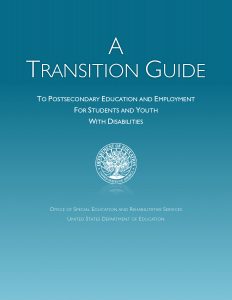
US DOE OSERS Releases New Transition Resource Guide for Students
 The U.S. Department of Education’s Office of Special Education and Rehabilitative Services (OSERS) recently published A Transition Guide to Postsecondary Education and Employment for Students and Youth with Disabilities (62 pg. PDF). The guide advances efforts to ensure all students and youth with disabilities develop the skills and knowledge to be engaged in the 21st century workforce. Additionally, it helps students and youth with disabilities and their families understand how state and local educational agencies and state vocational rehabilitation agencies collaborate to foster improved outcomes for students and youth with disabilities.
The U.S. Department of Education’s Office of Special Education and Rehabilitative Services (OSERS) recently published A Transition Guide to Postsecondary Education and Employment for Students and Youth with Disabilities (62 pg. PDF). The guide advances efforts to ensure all students and youth with disabilities develop the skills and knowledge to be engaged in the 21st century workforce. Additionally, it helps students and youth with disabilities and their families understand how state and local educational agencies and state vocational rehabilitation agencies collaborate to foster improved outcomes for students and youth with disabilities.
OSERS’ mission is to improve early childhood, educational, and employment outcomes and raise expectations for all individuals with disabilities, their families, their communities, and the nation. To assist students and youth with disabilities to achieve their post-school and career goals, Congress enacted two key statutes that address the provision of transition services: the Individuals with Disabilities Education Act (IDEA) and the Rehabilitation Act of 1973 (Rehabilitation Act), as amended by Title IV of the Workforce Innovation and Opportunity Act (WIOA). The IDEA is administered by the Office of Special Education Programs (OSEP), and Titles I, III and VI, section 509, and chapter 2 of Title VII of the Rehabilitation Act are administered by the Rehabilitation Services Administration (RSA). OSEP and RSA, both components of OSERS, provide oversight and guidance regarding the administration and provision of transition services by State educational agencies (SEAs), local educational agencies (LEAs), and State Vocational Rehabilitation (VR) agencies.
Both the IDEA and the Rehabilitation Act make clear that transition services require a coordinated set of activities for a student with a disability within an outcome-oriented process. This process promotes movement from school to post-school activities, such as postsecondary education, and includes vocational training, and competitive integrated employment. Active student involvement, family engagement, and cooperative implementation of transition activities, as well as coordination and collaboration between the VR agency, the SEA, and the LEAs are essential to the creation of a process that results in no undue delay or disruption in service delivery. The student’s transition from school to post-school activities is a shared responsibility. (Source: A Transition Guide to Postsecondary Education and Employment for Students and Youth with Disabilities, Preface, pg. v.)
